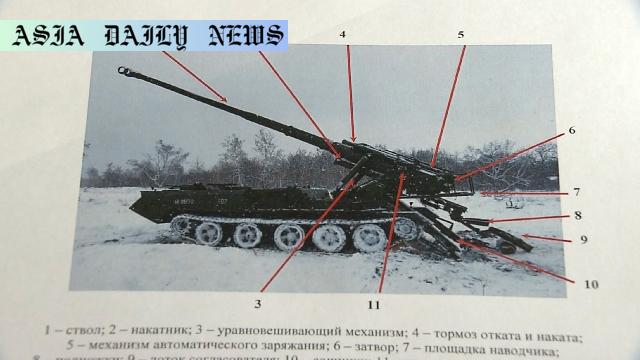North Korean artillery manual in Russian outlines advanced weaponry used in Ukraine conflict.
Key Point 1: NHK acquired a Russian-language operation manual for a North Korean self-propelled artillery piece.
Key Point 2: The ‘Juche Cannon’ artillery piece, with advanced specs, aids Russia in Ukraine’s conflict.
Key Point 3: The manual includes detailed instructions, showcasing military collaboration between North Korea and Russia.
Key Point 4: Long-range weaponry, like the ‘Juche Cannon,’ plays a crucial role in modern warfare due to surveillance technology.

Introduction: Unveiling the North Korean Artillery Manual
NHK, a prominent Japanese broadcaster, has recently come into possession of an operation manual for a North Korean self-propelled artillery unit, the ‘Juche Cannon.’ Surprisingly, the document is composed in Russian, sparking significant geopolitical concerns. The manual underscores the extent of technological and military cooperation between Moscow and Pyongyang, especially in light of ongoing global conflicts.
This guide, seemingly intended for Russian military use, highlights important MilTech complexities. It not only sheds light on the artillery piece’s technical prowess but also its battlefield importance. The discovery adds a new dimension to the dynamics between North Korea, Russia, and the ongoing conflict in Ukraine. This article delves deep into the details revealed through the manual and their broader implications.
Technical Specifications of the ‘Juche Cannon’
The ‘Juche Cannon’ is no ordinary artillery piece. Boasting a caliber of 170 millimeters, it has a remarkable range of over 50 kilometers and can fire two shells per minute. Such specifications make it a potent long-range weapon, capable of significantly influencing battlefield tactics. In modern warfare, where drones and surveillance offer constant visibility, the presence of such advanced artillery equips forces with a substantial tactical advantage.
The manual meticulously details the adjustment mechanisms, part maintenance instructions, and firing protocols. Richly illustrated with photographs, it serves as an invaluable resource for its operators. Additionally, a comprehensive table of firing angles showcases the attention to detail put into creating such documentation. The production of this manual in Russian further confirms that North Korea and Russia are aligning their military resources to formidable effect.
North Korea’s Growing Role in the Russia-Ukraine Conflict
The discovery confirms what many experts have suspected: North Korea is actively supplying weapons to support Russia’s objectives in Ukraine. By providing cutting-edge artillery systems, Pyongyang positions itself as a pivotal ally to Moscow. This deepened cooperation is not merely a military exchange but a politically charged statement in an increasingly multipolar world.
Associate professor Koizumi Yu emphasizes the strategic importance of sharing long-range, powerful military assets. Given the surveillance capabilities provided by drones, such weapons dictate operational success on the battlefield. The revelations further highlight a troubling alliance that could shape future geopolitical conflicts.
The Global Impact of the Discovery
Military experts and geopolitical analysts alike will be dissecting the ramifications of this discovery for months to come. For Ukraine, understanding how to counter such artillery becomes a strategic necessity. For Russia, demonstrating adept handling of these weapons could tilt battlefield outcomes. Meanwhile, North Korea’s military exports move beyond rhetoric to concrete action, symbolizing its emergence as a global player in conflict aid.
The presence of North Korean artillery on European soil also calls for a broader international response. This collaboration challenges existing sanctions and raises questions about the effectiveness of global deterrence mechanisms. For countries allied with Ukraine, engaging diplomatically with both Russia and North Korea becomes imperative to curb this escalating coalescence of hostile forces.
Conclusion: The Future of Wartime Collaboration
The ‘Juche Cannon’ manual is more than a technical document; it is a symbol of North Korea’s alignment with Russian interests. It showcases the indelible imprint of modern global alliances, emphasizing how regional players can influence international conflicts. The intricate details of this manual offer not only insight into battlefield strategies but also a sobering portrait of escalating power dynamics.
As technology advances and strategic military cooperation deepens, experts must prepare for a future where such collaborations become the norm. Whether this future fosters global security or greater conflict remains a question the world must collaboratively address.
Commentary
North Korea’s Increasing Impact on Geopolitical Security
The revelation of a Russian-language manual for North Korean artillery introduces an alarming new aspect to the global security landscape. The apparent depth of cooperation between Pyongyang and Moscow underscores an alliance that has graduated beyond mere diplomacy. Rather than passive spectators, North Korea has played an active role in supporting Russia’s military endeavors, exposing the interconnected nature of modern conflicts.
The Role of Advanced Technology in Modern Warfare
What sets the ‘Juche Cannon’ apart is its advanced technical capabilities. In an era where drones and precision targeting redefine the rules of engagement, weapons with extensive range and repeat firing abilities are game-changers. The compatibility of such artillery with Russia’s military needs unfolds broader questions about the effectiveness and proliferation of advanced weaponry in conflict zones. North Korea’s contribution in this regard signals its aspirations to be a serious contender in the global arms trade.
The Necessity for a Proactive International Response
This development should galvanize international efforts to reassess sanctions and diplomatic stances toward North Korea and Russia. It is evident that both nations are circumventing global restrictions and norms via strategic partnerships. The growing military collaboration between these countries must be met with a robust, unified response that not only curbs further exchanges but also mitigates their effects on vulnerable nations like Ukraine.
In conclusion, the discovery of the North Korean artillery manual is a stark reminder of the shifting dynamics in global security. It illustrates the urgent need for vigilance, innovation, and unity among nations dedicated to maintaining peace and stability in an increasingly fragmented world.


